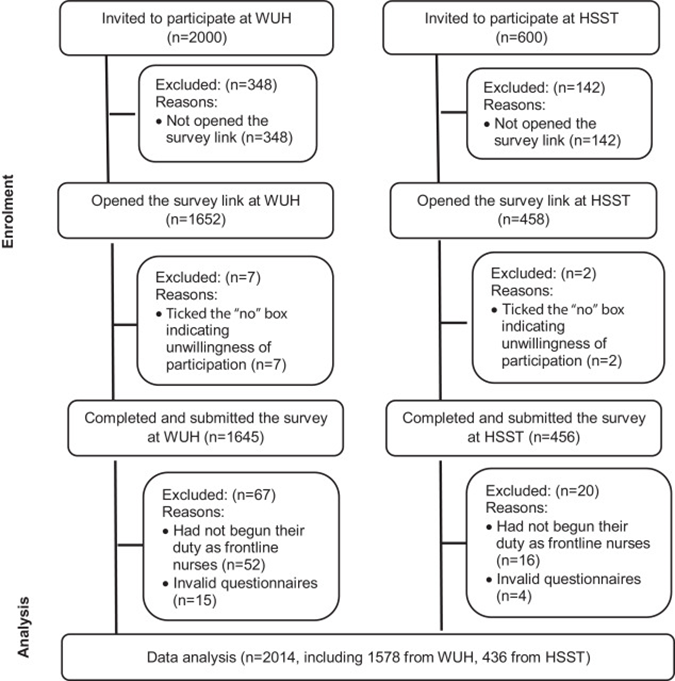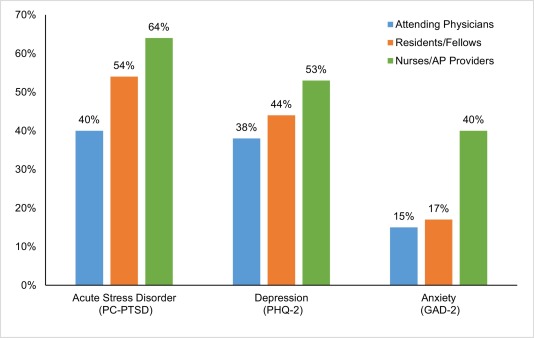Abstract
‘Frontline burnouts, depression, fear and anxiety status of nurses and their associated factors’ is the article’s title addressing the outbreak of COVID-19 in Wuhan, China. The article used an extensive cross-sectional quantitative methodology that involved 2,014 frontline nurses from China as the key participants. Besides, the researchers also used correlational and descriptive studies to collect the required data—the research aimed at assessing the level of mental health among nurses in China.
An overview of the findings was that most participants had high fear levels with moderate burnout. The fear was because the nurses experienced a mental challenge of thinking about the dangers of contracting COVID-19. These diseases of the frontline nurses were measured using respective Chinese scales, and a t-test was completed to analyze the collected data. Researchers established from the analysis that most nurses did not report to their duties because they were afraid and depressed because of the virus.
However, most of the participants were interested in joining the frontline work to save their citizens; hence, they decided to put forward suggestions to support their work and the safety of their citizens. The mental health problems among the nurses were a result of fear, burnout, and depression. The critical implication displayed from the research was that the frontline nurses put their lives at stake to care for their clients hence requiring promotions and better payments.
Introduction
The novel COVID-19 is still a dreaded disease worldwide, hence qualifying to be a public health emergency. The key questions addressed are anxiety, fear, depression, and burnout among the frontline nurses and the existing relationships between the abovementioned variables. Besides, there is a presentation of the differences in the variables between background subgroups related to COVID-19 and various socio-demographic aspects of nurses. As a result, the disease has increased the rates of nurses’ deployment in which they move to the areas where the citizens are much affected.
The frontline nurses are vulnerable to the disease because they stay in touch with positive patients daily. They are under threat from an unprecedented amount of coronavirus related to psychological stress across the profession and the individual domains. The health workers union of China said the circumstances of death resulted from the frontline nurses taking care of the patients with corona (Hu et al., 2020). This paper will look at a 2014 study of nurses from hospitals in Wuhan, in which the intervention was carried out through an online survey (Hu et al., 2020). The findings were analyzed to look for relationships between working on the front line with coronavirus and indicators of burnout, anxiety, depression, and the appearance of skin diseases.
Methods
The review protocol for this study is available; it was attached as an additional file accessible from the article’s website. The study design originated from the first wave of the coronavirus healthcare workers study, the cross-sectional survey of the workers within a large medical center in China. As mentioned, the critical methods used in data collection included a large-scale cross-sectional correlational and descriptive study. The study has contended in two major hospitals in Wuhan City in which one hospital had three divisions that got converted into venues meant for COVID-19 patients only.
Additionally, the frontline nurses were also given a survey link in which they were to respond to questions about COVID-19 concerning their profession. The total number of participants who opened the link was 2110, and they completed the questionnaires and submitted them. During the survey, 0.4% ticked the ‘no’ section withdrawing a population of 99.6% who participated; hence the discussion was based on their feedback (Hu et al., 2020).
Psychological Screening
The entire process used screening in which the frontline was screened of their anxiety, depression, skin lesion, and fear level. The methods were exact because each aspect possessed its specified screening tool. The burnouts of the nurse were screened using a Chinese Maslach Burnout Inventory tool that contained mainly 22 items having three specific dimensions. The three dimensions were depersonalization, personal accomplishment, and emotional exhaustion.
Nurses measured the three dimensions on a Likert scale in which higher scores implied that there was a severe burnout. Anxiety was measured using a self-measuring anxiety scale, while depression was measured using a self-rating depression scale that worked just like the burnout scale. Hig values showed that the levels of depression, fear, or anxiety were similar. The nurses’ resilience and self-efficacy screening were slightly different because they had ten items, each measured using a five-point on the aforementioned Likert scale (Hu et al., 2020). The higher the score on the Likert scale, the better the nurse’s resilience and self-efficacy.
Coronavirus Sources of Stress
Researchers made an instrument based on agreement from several discipline providers, which was done with the supplementation of literature entailing the Virus-related sources of stress among the workers. Those who participated in the activity rated how much pressure they encountered on items within the state policies and the COVID-19 guidelines, personal and clinical environment. This article is provided in English under the Creative Commons license. New information for 2019-2020, considered in the article, allows getting relevant data in the open access to continue research.
Working with Data
The primary source of information in this study is an online survey, which resulted in a database with answers. This view keeps in touch with the participants; the last date for accessing the data was highlighted on February 24, 2020 (Hu et al., 2020). Full electronic search strategies encompass mainly the search syntax of database languages involving queries using boolean operations. Restrictions are set for specific goals: for example, selecting appropriate age groups and assessing results within them. The studies for this work were selected according to the keywords: there were still few works on COVID-19 at that time, along with the currently known information about occupational burnout and the related psychological symptoms. These aspects are determinants of inclusion in the systematic review.
The selected reports are extracted independently and with the help of logic, and due to the lack of experience, new knowledge is synthesized, which is supported empirically. The primary data on which the search results were requested include involvement in the local situation of the origin of the coronavirus, its spread in medical facilities in Wuhan, and the physical and psychological reactions of nurses. In addition, the already known information about burnout, anxiety, and fear and the reflection of these feelings on a person’s physical health was used.
The study addresses a specific problem within which bias can only be detected at the study design stage, as online nursing surveys have not been empirically tested in any way. Nevertheless, the questionnaire’s quantitative data were assessed on the Likert scale, and internal consistency was supported by a high Cronbach alpha. Anxiety and depression were assessed using the Zung scale; another questionnaire was used for fear, the validity of which was assessed by ten experts. Cronbach’s alpha did not fall below 0.7 for any questionnaire, and experts were also recruited to assess the validity of the skin lesion scale (Hu et al., 2020). Risks are also mitigated by a reasonably large sample, preliminarily excluding nurses with mental disorders; the risk ratio has been minimized too.
Results
Figure 1 below summarizes the survey technique used in the research, studies screened and assessed.

For the results, socio-demographic data, time, and duration of work were extracted to find a correlation with the results of the questionnaires. As a rule, gender, presence of children, marital status were chosen. The fact of training or experience in caring for patients with infectious diseases was also taken into account. There is little risk of bias in the study, but the results were accepted with a reasonably low p-value.
The intervention group was a general sample, the results within which were analyzed in three directions. First, in the socio-demographic data, the average value for each item was highlighted, a correlation was made between the mental state. Second, a relationship was found between mental state and consequences: burnout, anxiety, and other highlighted variables. Due to the high confidence interval, the results are statistically significant. Therefore, it was found that anxiety, fear, and depression strongly correlate with frontline work with the virus, while skin lesions have a weak correlation. Self-efficacy and resilience were negatively correlated with mental disorders, reflecting the resilience of nurses in a crisis.
Discussion
Psychological Screening
Relative to other sources, fewer participants reported high stress about the government policies and discharge guidelines for patients with coronavirus, their time spent in clinics, or insomnia. The people who were able to complete the survey were different from those who had not yet completed the survey. A bigger proportion of the participants who went for screening had positive results for psychological effects of coronavirus as in figure 2 50% of the individual participants screened positive for acute stress, 40% screened for depressive symptoms, and 30 % screened positive for anxiety.

Limitations
Concerning the study’s limitations, it was not easy to contact a face-to-face interview or surveys because China was on total lockdown in which online forms suited the situation. Additionally, the results were limited by convenience sampling, which may not accurately reflect the overall status of HCWs in China (Hu et al., 2020). Additionally, because of time constraints, the scale we used is so essential that it can only provide a preliminary screening; further confirmation and intervention are required.
Conclusion
The novel coronavirus had spread to 73 countries on all continents except Antarctica by the time researchers submitted this study. The European Union had upped the danger level of coronavirus to high from moderate (Hu et al., 2020). HCWs in other countries may face similar challenges as those in China, so individuals should address their needs and psychological state sooner rather than later. The unique experience of the pandemic made it necessary to conduct such studies. Further work based on the interpretation of the findings will focus on the practical implementation of various techniques that will help reduce the likelihood of burnout, anxiety, fear, skin diseases and improve resilience in difficult situations such as a pandemic in nurses. A comprehensive solution can subsequently be extended to each representative of medicine since each person’s effort will be required to defeat the pandemic.
Funding
Regarding the funding of the review, it was funded by the 2020 COVID-19 Emergency Response Special Fund from Xiamen and Huanhong University of Science and Technology in China. The funders helped in organizing the methodology and participants’ involvement in the study. They ensured that Hun et al. (2020) availed all the requirements for the experiment, analysis, interpretation, writing and submission before beginning the procedures.
Reference
Hu, D., Kong, Y., Li, W., Han, Q., Zhang, X., Zhu, L. X.,… & Zhu, J. (2020). Frontline nurses’ burnout, anxiety, depression, and fear statuses and associated factors during the COVID-19 outbreak in Wuhan, China: A large-scale cross-sectional study. EClinicalMedicine, 24, 100424. Web.
